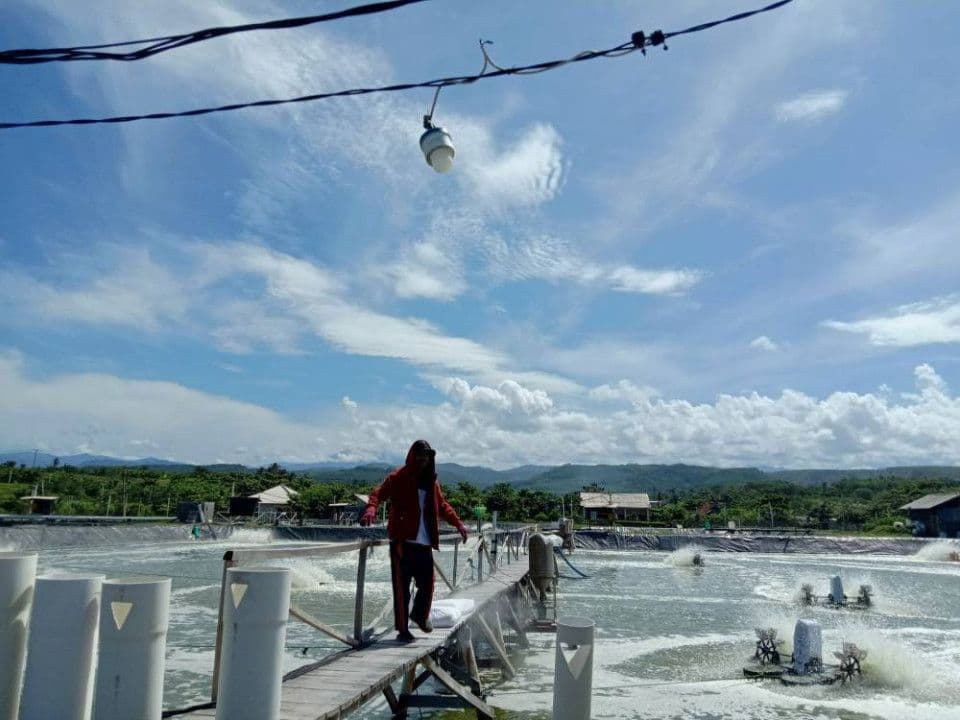
Treatments in shrimp cultivation involve the application of materials or chemicals to optimize pond conditions for shrimp. These treatments are important to prevent farming losses due to diseases. Here are 7 treatments shrimp farmers can try.
Chlorine
Chlorine can reduce the amount of pathogenic bacteria and viruses in shrimp ponds. Chlorine can also bind to Fe and prevent shrimp stress in the beginning of the cultivation process.
The application of chlorine is best done simultaneously after all ponds have been filled with water, so that the water can be optimally sterilized. If not, harmful organisms from unsterilized ponds can spread to sterilized ponds. The recommended level for chlorine application is 20-60 ppm.
Lime (CaCO3 and Ca(OH)2)
CaCO3 (limestone) and Ca(OH)2 (slaked lime) are two common types of lime used to increase the pond water pH and speed up the molting process in shrimp.
Lime is best applied at night as it is the optimum time for molting. Other types of lime that can be used by shrimp farmers are dolomite lime and quicklime.
Probiotics
Probiotics are bacteria that promote benefits for shrimp ponds, which include Bacillus, Pseudomonas, and Thiobacillus. Applying probiotics can maintain pond water quality and prevent the growth of harmful microorganisms such as Vibrio, as well as control ammonia levels in the water. Probiotics are also safer to use than antibiotics as the latter can cause resistance in shrimp.
Probiotics can be applied orally or to the environment. Orally, they are mixed in shrimp feed to strengthen the shrimp’s gut and immunity. When applied to the environment, probiotics are spread directly into the pond.
Molasses
Molasses are waste products from cane sugar processing that still contain around 48-56% sugar. Molasses optimize the growth of probiotics as they serve as a carbon source in the pond.
Fermentation
Fermentation is an organic fertilizing method to increase the growth of natural feed (plankton) in the pond. Bran and soybean meal are commonly fermented.
The fermentation process usually requires 2 days before being applied to the pond. If the process is successful, the pond water will gradually turn bright green or opaque.
Inorganic fertilizer
The amount of natural feed in shrimp ponds can also be increased by inorganic fertilizers, such as ZA fertilizer. Unlike fermentation, inorganic fertilizers can be directly applied to the ponds. It also dissolves more easily and can be readily utilized by organisms which contain chlorophyll.
Saponins
Saponins are derived from tea plants and used to kill pests such as predatorial small fish. Saponins are best applied at 09.00-12.00 for more effective and efficient results by soaking them in water for 2 hours. They can be applied according to the pond water salinity; around 20 ppm for < 15 ppt salinity and 15 ppm for ≥ 15 ppt salinity.
We hope this information can help shrimp farmers determine the best treatment to optimize their shrimp farms!
References:
Ghufron M, Lamid M, Sari PDW, Suprapto. 2017. Teknik pembesaran udang vaname (Litopenaeus vannamei) pada tambak pendampingan PT Central Proteina Prima Tbk di Desa Randutatah, Kecamatan Paiton, Probolinggo, Jawa Timur. Journal of Aquaculture and Fish Health. 7(2): 70-77.
Husaeni H, Sudarmayasa IKA. 2018. Pemberian probiotik pada budidaya udang vaname (Litopenaeus vannamei) semi intensif di tambak. Buletin Teknik Litkayasa Akuakultur. 16(1): 57-60.
Kurniawan S. 2016. Aplikasi probiotik (Bacillus sp.) pada budidaya udang vannamei (Litopenaeus vannamei) di tambak udang intensif Sidojoyo Group, Banyuwangi, Jawa Timur. Surabaya(ID): Universitas Airlangga.
Suriawan A, Efendi S, Asmoro S, Wiyana J. 2019. Sistem budidaya udang vaname (Litopenaeus vannamei) pada tambak HDPE dengan sumber air bawah tanah salinitas tinggi di Kabupaten Pasuruan. Jurnal Perekayasaan Budidaya Air Payau dan Laut. 14: 6-14.
Suryono, Wibowo E, Azizah R, Ario R, Handoyo G. 2017. Pengaruh penggunaan kaporit sebagai desinfektan terhadap daya aroma pakan pada budidaya udang windu (Penaeus monodon Fabricius). Jurnal Kelautan Tropis. 20(2): 140-144.
Suwoyo HS. 2016. Prinsip budidaya udang vaname (Litopenaeus vannamei) di tambak dengan teknologi ekstensif plus. Balai Penelitian dan Pengembangan Air Payau.
Widanarni, Saputra WH, Wahyuningrum D. 2011. Pengaruh penambahan molase terhadap kelangsungan hidup dan pertumbuhan larva udang windu Penaeus monodon Fab. Yang diberi bakteri probiotik Vibrio SKT-b. Jurnal Akuakultur Indonesia. 10(2): 106-115.
Yunus R, Haris A, Hamsah. 2020. Pengaruh penambahan kapur dolomit dan kapur tohor dalam media pemeliharaan terhadap moulting, pertumbuhan, dan sintasan udang vaname (Litopenaeus vannamei). Jurnal Ilmu Perikanan. 9(1): 39-47.





